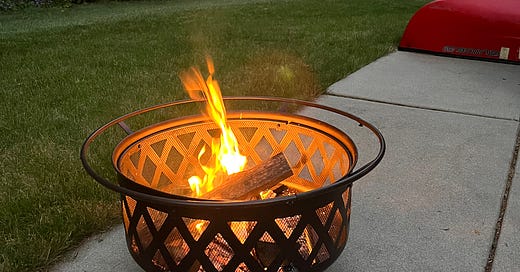I will keep beating this drum for as long as it takes: hospitality is not entertaining. It’s not competitive charcuterie. It’s welcoming people into your imperfect home and life, creating space for connection. Hospitality is not a “gift” that some folks have and some don’t. It’s a practice, and we can all engage in our own way. (I know you were probably told otherwise along the way. But what if we need to deconstruct hospitality and reclaim it?)
Still, welcoming sometimes feels hard. But the good news is, you can wade into the shallow end of the pool. You don’t need to decorate or curate or impress.
Often the best place to start is at home, with your own family. Here are three possible ways to practice welcoming.
Welcome your own kids (and their friends)
Scot and I splurged this week and purchased a $60 metal fire pit from Menard’s. (Minus the 11 percent rebate!) I know, I know—tell me you’re a Midwesterner without telling me you’re a Midwesterner.
Our home has a fireplace, which I use a lot in the winter.
Summer’s here, so the backyard patio now has a fire pit. Which I inaugurated last night. I sat in the twilight, watching the flames dance as the stars came out.
I texted my daughter a picture of my backyard campfire, asking if she remembered how I used to keep marshmallows, graham crackers and chocolate in the pantry. She’d invite her friends to our house on a Friday or Saturday night, after they’d been out at a game or some other event. She knew I’d have a fire going and they could make s’mores. Her friends knew they were welcome at our home.
If you live with teenagers, I know. It’s not easy. But you can practice hospitality by simply making sure they know that their friends are welcome, and there will be snacks.
I can already hear your objections: Teens eat a lot. I get it. I’m not saying you have to order a pizza every time your kids’ friends show up. But our kids’ friends felt welcomed, not just by the food, but by the lack of fussiness, the simplicity of it. They were welcome in our house.
Note: teens are like wild birds. Beautiful, a little messy, and skittish. Put out food and observe from a distance. Don’t hover. Be available but stay out of the way. You might be surprised at what happens.
What if the practice of welcoming could start with your own kids and their friends? They don’t care about a tablescape or a fancy dinner. Keep a few snacks or s’mores fixings in your pantry, and let your kids know their friends are welcome any time.
Welcome your spouse
This one isn’t easy. What can you do to make your spouse feel at home? That may sound like a weird question, especially if you are still in the midst of revising what you mean when you talk about hospitality. But do we welcome our spouse in the way we’d welcome a friend? Do we hold space for their stories? I mean, they live there, but do they feel welcomed?
I am sometimes surprised to discover how much my husband appreciates just being listened to. It’s been said that most people cannot distinguish being loved from being listened to, because they feel the same.
What if you could welcome your spouse by creating a little space to just listen? To let them vent about their day, to hear and hold their story, without correcting them or saying, “Well, in that situation you should have…” Don’t hand them a list of chores or problems to solve. Just give your attention.
Photo by Marcus Aurelius: https://www.pexels.com/
(Also, it is okay to make sure this practice gets reciprocated. It’s okay to ask for what you need. I sometimes have to say, “Can you just listen? I want to process. I don’t want you to fix it, just listen.”)
This is a helpful practice because if you can do it with your spouse, you can do it with anyone!
Gather at the table
Research shows that kids who eat meals with their families are healthier physically and emotionally. They eat more fruits and vegetables, they do better at school. They thrive.
According to the FMI Foundation:
“Regular family meals are also associated with lower rates of depression, anxiety, substance abuse, eating disorders, tobacco use, early teenage pregnancy, and higher rates of resilience and higher self-esteem, all of which impact mental health.”
I am a huge family meals advocate. I grew up gathering with my family every night for dinner. My husband, not so much. His large family had considerably less structure.
So, when we had a family of our own, I insisted on family meals as often as possible. (Admittedly, a challenge during the years when both kids were in sports.) My husband is a realtor, and he was often working in the evenings when our kids were young. But whether he was able to join us or not, we made family meals a priority. It could be very simple, what mattered was the gathering. (I decided it was still a family meal if, as the bible says, two or three were gathered).
One summer (Scot’s busy season) I decided our family meal could sometimes be breakfast. The kids were home, I was working from home. Scot was more available in the mornings more than at dinner time. I’d make eggs or pancakes or even just throw frozen waffles in the toaster.
As they got older, I invited them to help cook, which turbo-charged their enthusiasm for meals. Both my kids are now solid cooks.
Family meals offer kids a chance to learn the art of conversation, table manners, and how to make healthy food choices. But they don’t only have to happen at the kitchen table—especially in summer. You can be creative. Pack sandwiches and fruit in a backpack, take your kids on a bike ride, and eat picnic style at the park. Or let them roast hot dogs over a backyard campfire.
Photo by Anna Tarazevich: https://www.pexels.com/
Welcoming others is a spiritual practice. When we practice something, we don’t have to do it perfectly. We learn as we go. Why not practice welcoming your family?
Leave a comment: how do you practice welcoming with your family?
P.S. Looking for inspiration about how you can welcome others, especially kids? You’ll want to read my newest book, a collaboration with David and Karen Anderson, Unleashing Radical Hospitality. Click here to learn more about this inspiring resource.








Several summers in a row, we hosted a half dozen teenage woodworking students from a good friend's high school program two states away. The top performers in the class were invited to submit essays and applications for full-ride scholarships to Andy Chidwick's week-long woodworking camp in Montana--a very big deal for these city kids. They worked long hours in the woodshop, but they also got to hike, swim in the river, and sit around the campfire in the evenings. Each summer we asked the students what the best part of the week had been. EVERY YEAR, the students reached the same conclusion: the best part of the week was eating meals together around the table, saying grace and passing dishes around "like the families on TV." None of them did that in their own homes. Every year. It amazed us every time.
Good ideas and reinforcement. Particularly important to me is your suggesting that hospitality, while simple, does need to be intentional. Welcoming your spouse can change you life! Thanks for reminding me. If I am so stressed from preparing for hospitality, I become a poor version of myself, best I look at simplifying the preparation.